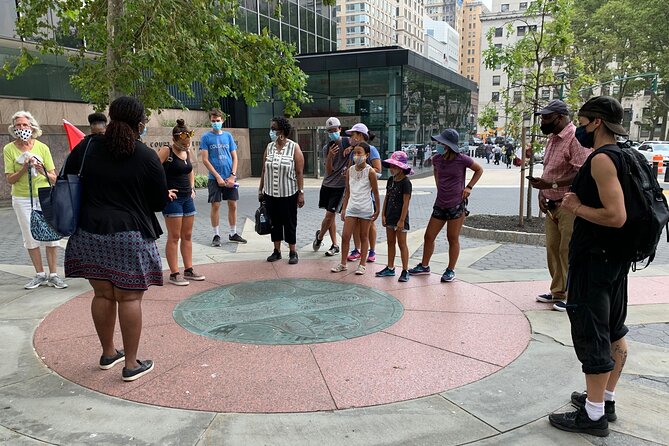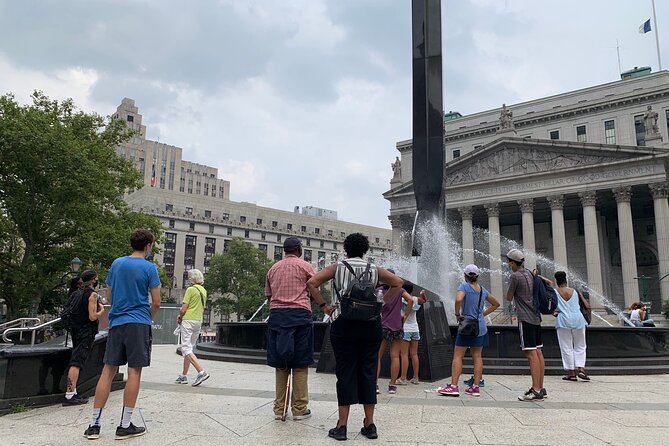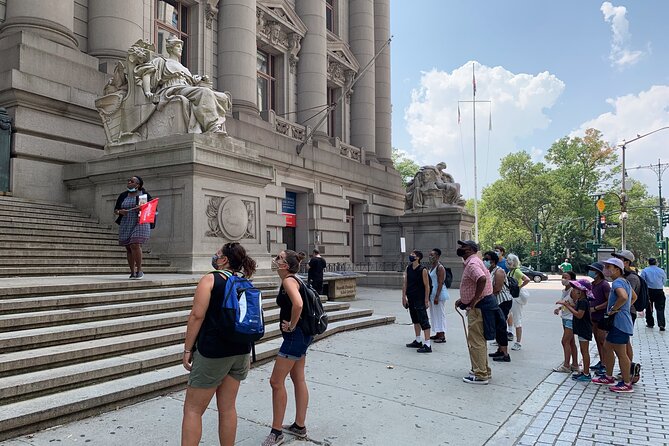New York City’s past as a hub of the abolitionist movement comes alive on the Slavery and Underground Railroad Tour. Visitors explore significant historical sites, uncovering the city’s pivotal role in the fight for emancipation. Knowledgeable guides share the compelling stories of key figures, offering a profound understanding of the struggle for freedom. Whether you’re a history buff or simply curious, this walking tour provides an intimate and engaging experience – one that’ll leave you eager to discover more about America’s complex past.
Key Points

- This walking tour explores NYC’s pivotal role in the abolition movement and the Underground Railroad, visiting former safe houses and significant sites.
- Knowledgeable guides provide engaging narratives about abolitionist figures and their efforts to help runaway slaves, offering valuable historical insights.
- The tour includes stops at the National Museum of the American Indian, Battery Park, Fraunces Tavern Museum, Wall Street, and the African Burial Ground National Monument.
- With a 5.0 rating and 366 positive reviews, the tour is praised for its informative and thought-provoking experience, suitable for history enthusiasts of all fitness levels.
- Participants can expect an immersive journey through time, tracing the city’s complex history and uncovering the hidden stories of the abolitionist movement.
Tour Overview and Highlights

The New York City Slavery and Underground Railroad Tour explores the city’s pivotal role in the abolition movement, allowing visitors to trace the historic paths of the Underground Railroad and learn about the courageous individuals who aided enslaved escapees.
With a Badge of Excellence and 366 glowing reviews, this tour promises an immersive journey through the city’s storied past.
Guests will discover former stations and safe houses that sheltered runaway slaves, visit significant sites like Fort Amsterdam and the African Burial Ground National Monument, and gain insights into the lived experiences of those who sought freedom.
Woven throughout the experience are the stories of abolitionist figures and their tireless efforts to dismantle the institution of slavery.
Tour Itinerary

The tour begins at the National Museum of the American Indian, where guests embark on their exploration of New York City’s pivotal role in the Underground Railroad and the abolition movement.
After a stop at Battery Park, the group visits the Fraunces Tavern Museum to learn about the city’s abolitionist history.
Next, they’ll walk down Wall Street, discovering where slaves once hid from their captors.
The tour continues at Foley Square before concluding at the African Burial Ground National Monument, a somber reminder of the city’s complex past.
Throughout the journey, travelers gain insights into the courageous individuals who fought to end slavery and the harrowing experiences of those who sought freedom.
What to Expect
Participants can expect a guided walking tour that traces the history of slavery and the Underground Railroad in New York City, providing insights into the role of slaves in American society and the contributions of abolitionist figures.
The tour takes travelers on a journey through time, with knowledgeable guides sharing engaging stories and revealing how New Yorkers aided escapees.
The tour is suitable for those with a moderate level of physical fitness, with a maximum of 30 travelers. Accessibility is ensured, as the tour is wheelchair and stroller-friendly.
Whether you’re an American history enthusiast or simply seeking a thought-provoking experience, this tour promises to be both informative and impactful.
Traveler Feedback

Praised for their knowledgeable guides and engaging storytelling, the New York City Slavery and Underground Railroad Tour has earned a stellar 5.0 rating based on 367 reviews.
Travelers have consistently found the tour to be eye-opening and informative, highlighting its importance in understanding American history. The guides’ passion and depth of knowledge have been widely acclaimed, as they successfully make the historical narrative relatable and impactful.
Many visitors have appreciated how the tour takes them on a journey through time, providing valuable insights into the role of slaves in American society.
Booking Information

Booking the New York City Slavery and Underground Railroad Tour starts from $49.00, with a lowest price guarantee. Free cancellation is available up to 24 hours before the tour.
The meeting point is 1 Bowling Green, New York, NY 10004, in front of the National Museum of the American Indian, while the tour ends at the African Burial Ground National Monument, 290 Broadway, New York, NY 10007.
This guided walking tour provides an in-depth exploration of the history of slavery and the Underground Railroad in NYC. With a maximum group size of 30 travelers, the tour is suitable for those with a moderate fitness level.
The tour is wheelchair and stroller accessible, ensuring accessibility for all visitors.
Exploring NYC’s Freedom Trail

The tour takes visitors on a captivating journey through New York City’s storied past, tracing the integral role the city played in the Underground Railroad’s efforts to liberate enslaved individuals. As guests traverse the Freedom Trail, they’ll uncover the hidden histories of the city’s abolitionist movement, discovering how ordinary New Yorkers risked their lives to aid escapees. Along the way, the tour highlights significant landmarks, including:
| Site | Significance |
|---|---|
| Fort Amsterdam | An early Dutch settlement that served as a hub for the transatlantic slave trade. |
| Wall Street | Where enslaved individuals hid while awaiting passage to freedom. |
| Foley Square | Home to the African Burial Ground, a sacred site honoring the city’s forgotten enslaved population. |
Through this immersive exploration, participants gain a deeper understanding of New York’s complex history and its pivotal role in the struggle for emancipation.
Uncovering Abolitionist Contributions

As visitors explore the Freedom Trail, they’ll uncover the inspiring stories of the city’s abolitionist figures and their courageous efforts to aid the Underground Railroad.
The tour highlights three key abolitionists and their critical roles:
- Gerrit Smith, a wealthy landowner who provided safe passage and resources for escapees.
- David Ruggles, a free black man who operated a secret network of safe houses and information channels.
- Arthur and Lewis Tappan, prominent merchants who used their businesses to fund abolitionist activities and shelter runaway slaves.
Through these personal accounts, the tour sheds light on the sacrifices and determination of those who risked everything to fight against the injustice of slavery in New York City.
Experiencing American History Firsthand

Embarking on the New York City Slavery and Underground Railroad Tour allows visitors to experience American history firsthand, seeing the captivating narratives that shaped the nation’s struggles with slavery. As participants traverse the streets of Manhattan, they’re transported to a bygone era, uncovering the hidden stories of those who fought for freedom. From the African Burial Ground National Monument to the former hiding places along Wall Street, each site visited offers a tangible connection to the past, fostering a deeper understanding of the complex and often painful realities of slavery in America. This tour provides an invaluable opportunity to engage with history in a visceral, impactful way.
| Site Visited | Significance |
|---|---|
| Battery Park | Site of former slave auctions |
| Fraunces Tavern Museum | Played a role in the abolitionist movement |
| Wall Street | Location where slaves hid from capture |
| Foley Square | Home to anti-slavery rallies and activism |
| African Burial Ground National Monument | Honors the legacy of enslaved Africans in New York |
Recap
The New York City Slavery and Underground Railroad Tour provides a thought-provoking exploration of the city’s pivotal role in the abolitionist movement.
Knowledgeable guides share compelling stories, offering a profound understanding of the struggle for emancipation.
Visiting significant historical sites, travelers can experience American history firsthand and gain a deeper appreciation for the contributions of key abolitionists and runaway slaves.






